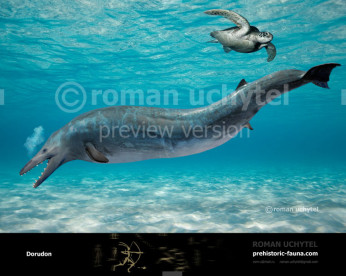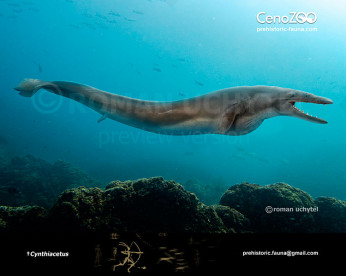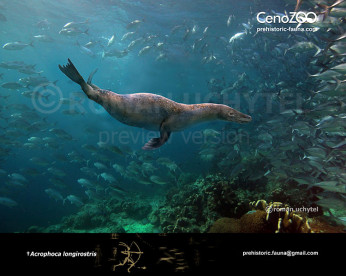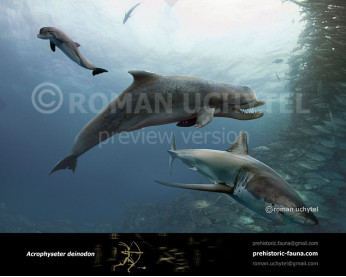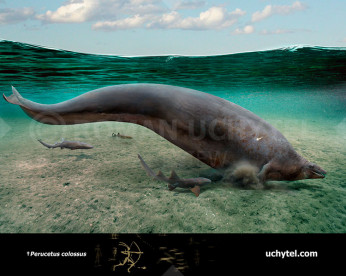Piscobalaena
2844928449
Piscobalaena (†Piscobalaena (G. Pilleri and H. J. Siber, 1989))
Order: Artiodactyla
Infraorder: Cetacea
Family: Cetotheriidae
Time period: lived 11.6 to 5.3 million years ago in the Middle to Late Miocene
Size: Body length of 5 metres. The skull is 1 metres long.
Piscobalaena is an extinct genus of cetaceans, looked much like whales today, which lived from the Middle to Late Miocene epochs in Peru and Florida. Its fossils have been found in the Pisco Formation of Peru and the Bone Valley Formation of Florida.
Piscobalaena is known for some well-preserved specimens, including three young individuals and an adult. Some characteristics of the skull distinguish this animal from modern whales (such as the shape of the supraorbital process). Piscobalaena is considered a representative of Cetotheriidae a group of baleen whales with primitive characteristics similar to that of Balaenoptera, fossil species of which have been found mainly in the northern hemisphere.
Other fragmentary remains attributed to Piscobalaena are also from Peru, but date a little older (late Miocene, about 10 million years ago). So it seems that this kind of whales were located in the Pacific coast of South America and evolved for at least five million years. Other fossils attributed with some doubt to Piscobalaena come from the Miocene Bone Valley Formation of Florida: If so, then Piscobalaena might have had a wider distribution than the Peruvian coast. This could have been because the Isthmus of Panama was open until at least Late Pliocene, allowing the passage of marine species from the Atlantic to the Pacific and vice versa. Other marine mammals found in the Pisco Formation include the odd dolphin Odobenocetops, the long-necked seal Acrophoca, and aquatic sloth Thalassocnus. At least some individuals of this diminutive whale were preyed on by the shark C. megalodon.
Payment
You may use multiple payment methods to buy image such as credit cards, PayPal and bank transfer.
Piscobalaena (†Piscobalaena (G. Pilleri and H. J. Siber, 1989))
Order: Artiodactyla
Infraorder: Cetacea
Family: Cetotheriidae
Time period: lived 11.6 to 5.3 million years ago in the Middle to Late Miocene
Size: Body length of 5 metres. The skull is 1 metres long.
Piscobalaena is an extinct genus of cetaceans, looked much like whales today, which lived from the Middle to Late Miocene epochs in Peru and Florida. Its fossils have been found in the Pisco Formation of Peru and the Bone Valley Formation of Florida.
Piscobalaena is known for some well-preserved specimens, including three young individuals and an adult. Some characteristics of the skull distinguish this animal from modern whales (such as the shape of the supraorbital process). Piscobalaena is considered a representative of Cetotheriidae a group of baleen whales with primitive characteristics similar to that of Balaenoptera, fossil species of which have been found mainly in the northern hemisphere.
Other fragmentary remains attributed to Piscobalaena are also from Peru, but date a little older (late Miocene, about 10 million years ago). So it seems that this kind of whales were located in the Pacific coast of South America and evolved for at least five million years. Other fossils attributed with some doubt to Piscobalaena come from the Miocene Bone Valley Formation of Florida: If so, then Piscobalaena might have had a wider distribution than the Peruvian coast. This could have been because the Isthmus of Panama was open until at least Late Pliocene, allowing the passage of marine species from the Atlantic to the Pacific and vice versa. Other marine mammals found in the Pisco Formation include the odd dolphin Odobenocetops, the long-necked seal Acrophoca, and aquatic sloth Thalassocnus. At least some individuals of this diminutive whale were preyed on by the shark C. megalodon.

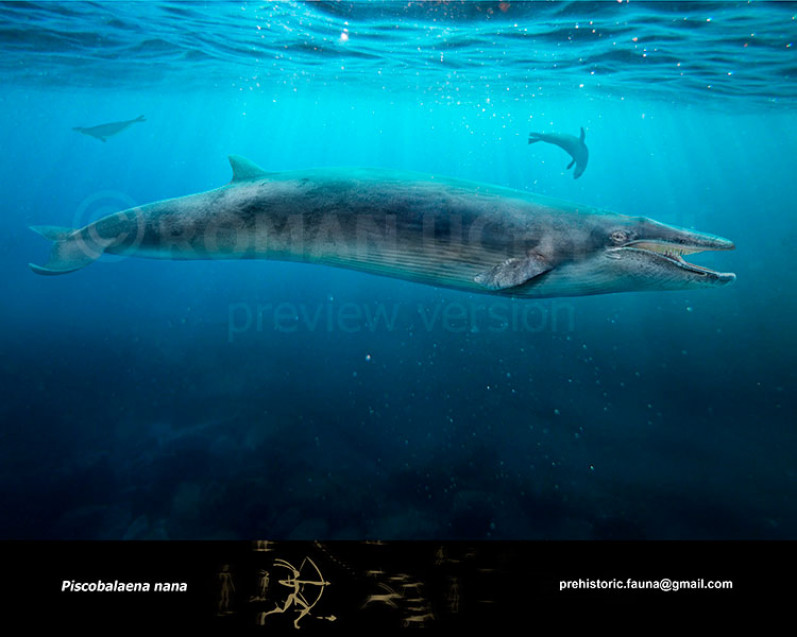
-797x638.jpg)

-70x56.jpg)
-346x277.jpg)
